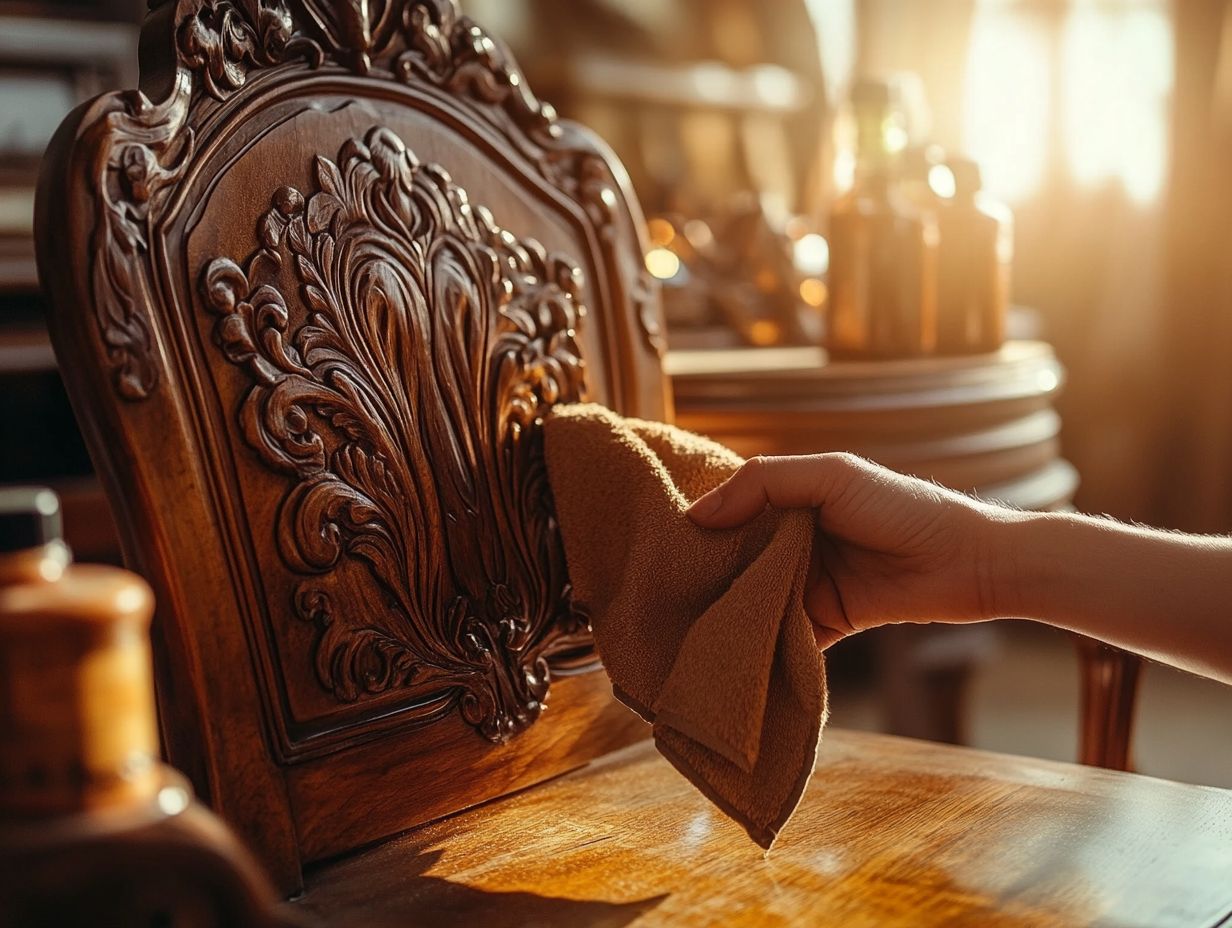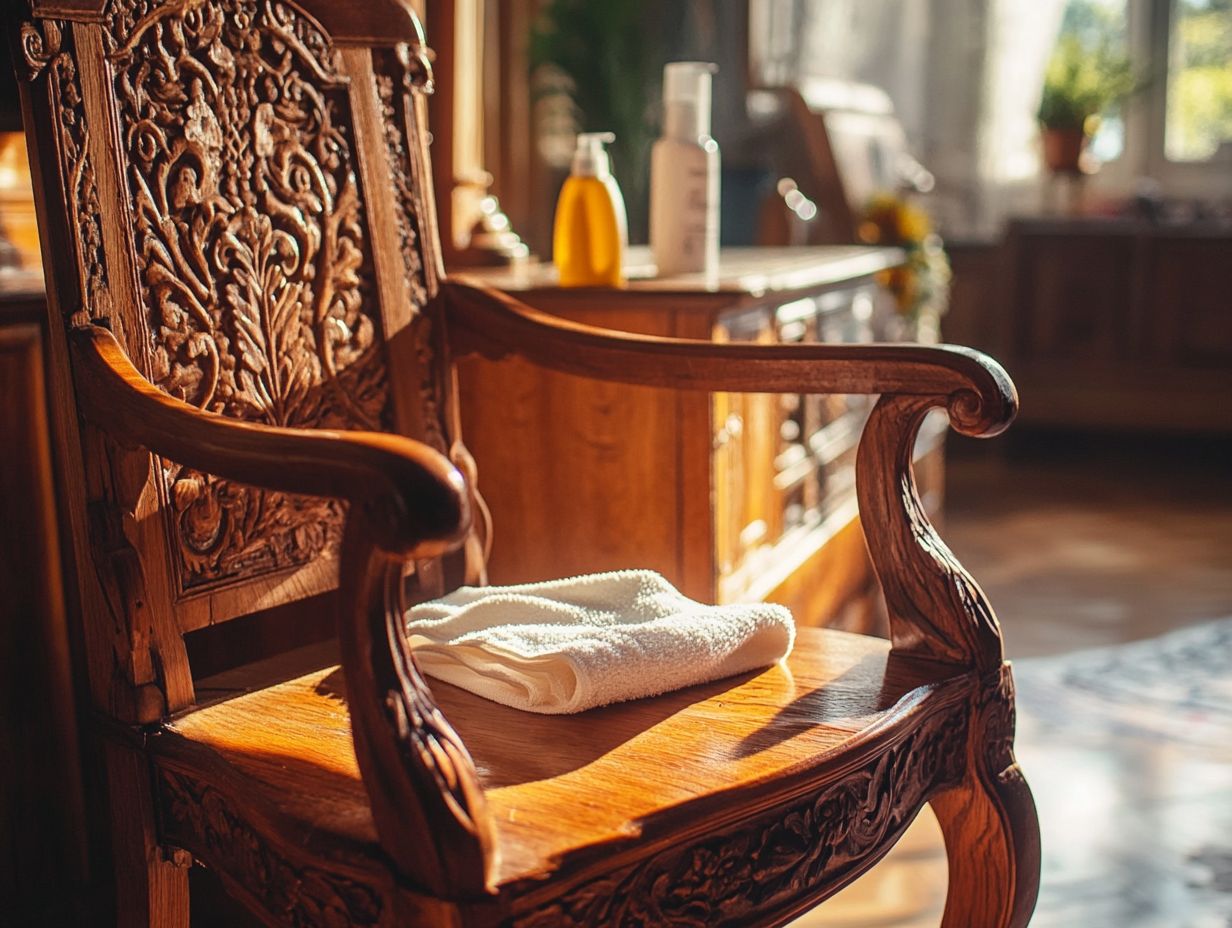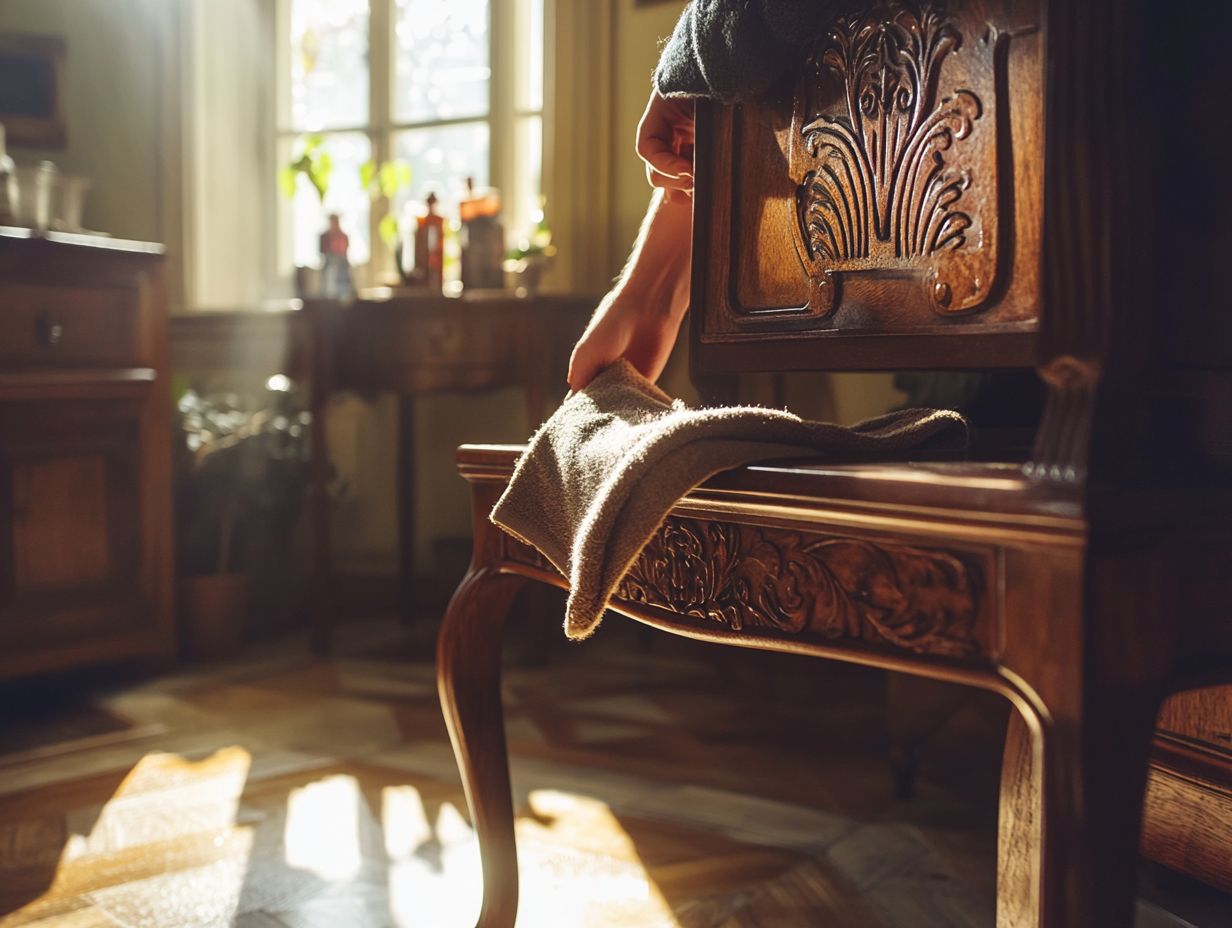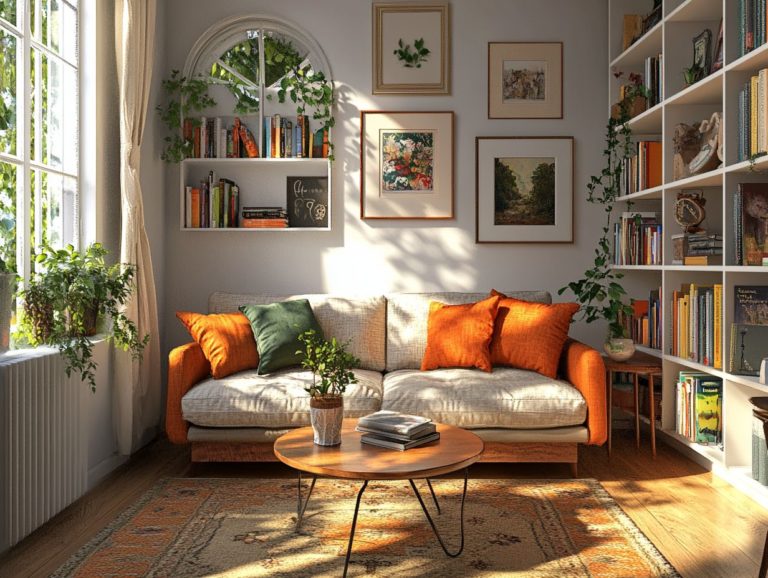How to Care for Antique and Vintage Wood Furniture
Antique and vintage wood furniture brings unique charm to any space. To preserve its beauty, a thoughtful approach to cleaning, maintenance, and repair is necessary.
This article delves into essential techniques for their proper care, covering everything from effective cleaning methods to safeguarding finishes.
You ll also learn how to identify authentic pieces and assess their value, ensuring your collection remains a genuine investment. Discover these exciting practices to keep your antique and vintage wood furniture looking stunning!
Contents
- Key Takeaways:
- What Makes Wood Furniture Antique or Vintage?
- Cleaning and Maintaining Antique and Vintage Wood Furniture
- Repairing and Restoring Antique and Vintage Wood Furniture
- Displaying and Storing Antique and Vintage Wood Furniture
- Identifying and Valuing Antique and Vintage Wood Furniture
- Frequently Asked Questions
- How to Care for Antique and Vintage Wood Furniture?
- What are the basic steps for caring for antique and vintage wood furniture?
- How often should I dust my antique and vintage wood furniture?
- What should I do if my antique and vintage wood furniture is damaged?
- How can I prevent my antique and vintage wood furniture from drying out?
- What should I do to protect my antique and vintage wood furniture from pests?
Key Takeaways:
- Proper cleaning and maintenance techniques are essential to preserving the beauty and value of antique and vintage wood furniture.
- Repairing and restoring antique and vintage wood furniture requires specialized techniques and should be done by a professional.
- To properly display and store antique and vintage wood furniture, consider factors such as lighting, temperature, and humidity. Identifying authentic pieces and understanding factors that affect value is also crucial for caring for these pieces properly.
What Makes Wood Furniture Antique or Vintage?
Antique wooden furniture and vintage wooden furniture are distinguished not merely by their age but also by the exceptional craftsmanship, high-quality materials, and timeless design aesthetics that have endured through the ages.
When you think about antique furniture, you’re generally looking at pieces that are over 100 years old. In contrast, vintage wooden furniture includes items that are at least 20 years old, yet don t quite reach the antique classification.
Proper care and maintenance of these exquisite pieces are essential for preserving their integrity and value. This includes cleaning antique furniture regularly to prevent dust buildup.
Cleaning and Maintaining Antique and Vintage Wood Furniture
Cleaning and maintaining your antique and vintage wood furniture is crucial for preserving its timeless beauty and functionality. It involves specific techniques designed to maintain both the wood finish and the overall integrity of the pieces.
Regular dusting with soft cotton cloths is essential, along with the use of specialized cleaning solutions that are gentle yet effective. Steering clear of harsh chemicals is key, as they can wreak havoc on the delicate wood grain and finish.
By giving your furniture the proper care it deserves, you ensure that it remains a stunning centerpiece for years to come.
Proper Cleaning Techniques
Proper cleaning techniques for your antique furniture require a gentle touch. Use mild cleaning solutions and soft materials to protect the wood while keeping it vibrant and intact. It s wise to don protective gloves and reach for cotton cloths when dusting or applying your cleaning solution; this will help preserve the wood finish and maintain the overall quality of your cherished pieces.
Consider utilizing beeswax polish or Murphy’s oil soap to elevate the surface. Beeswax polish is a natural product that protects wood and enhances its shine. For those interested in restoring vintage wood, it provides a nourishing protective layer that keeps the wood hydrated and reduces the risk of cracking or fading over time.
Be mindful that different types of wood, such as oak, mahogany, and pine, respond uniquely to cleaning methods. For example, oak can handle a slightly damp cloth, but more delicate finishes, like those on cherry wood, require extra caution with moisture.
Avoid harsh chemicals at all costs; they can strip the natural oils and finishes, leading to irreversible damage. Regular maintenance with the right tools will ensure that your antique treasures remain exquisite, allowing them to last for generations.
Protecting the Wood Finish
Protecting the wood finish of your antique and vintage furniture is vital for preserving its beauty and strength over time.
The longevity of these exquisite pieces relies heavily on the care you provide. They are vulnerable to various environmental influences, so it s essential to keep an eye on humidity in the storage or display area.
Using the right wax coatings boosts shine and protects against dirt and moisture. By regularly inspecting for changes in color or texture, you can catch early signs of deterioration, enabling timely interventions that maintain the unique characteristics of your vintage furniture. For those interested in more techniques, check out the basics of vintage furniture restoration.
Repairing and Restoring Antique and Vintage Wood Furniture

Repairing and restoring antique and vintage wood furniture is truly an art form that demands a deep understanding of various techniques and restoration products. It s about preserving the heritage and craftsmanship woven into each piece.
Common repairs include tackling structural issues, refinishing surfaces, and addressing damage inflicted by pests or environmental factors. For more detailed guidance, check out our article on how to care for vintage outdoor furniture. By doing so, you ensure that these cherished vintage wooden furniture items can continue to share their stories for generations to come.
Common Repairs and Restoration Techniques
Common repairs and restoration techniques for antique furniture often require your attention to damages inflicted by termites, rodents, or environmental wear. You ll want to use specialized restoration products designed to preserve the integrity of these vintage treasures.
This could involve repairing structural elements, refinishing surfaces, and applying protective measures against future infestations or damage.
For voids left by termite activity, epoxy injections a method to fill and strengthen wood damaged by pests can effectively reinforce the furniture’s overall stability. In terms of surface issues, consider options like Danish oil or polyurethane finishes, which provide a protective layer that keeps wood safe from moisture and scratches.
Careful restoration methods not only revive the piece to its former glory but also extend its lifespan, ensuring it remains a cherished part of your home for generations. For more insights, refer to the essential guide to vintage furniture care. Preserving craftsmanship and adding modern protective solutions helps to safeguard your antique furniture against future threats.
Displaying and Storing Antique and Vintage Wood Furniture
Showcasing your antique treasures can be a delightful experience if done right. Displaying and storing antique and vintage wood furniture properly is essential for preserving their quality and aesthetic charm.
Environmental conditions can significantly impact these treasured pieces, so it s vital to adopt the right techniques. By employing effective display methods and appropriate storage solutions, you can shield your furniture from humidity fluctuations and potential damage.
This thoughtful approach ensures that your timeless treasures remain in pristine condition for years to come.
Best Practices for Displaying
When showcasing antique furniture, it s crucial to understand humidity levels and various environmental factors to protect the integrity and finish of your cherished pieces. The best approach is to choose stable locations, steer clear of direct sunlight, and employ humidity monitors to maintain optimal conditions for preserving these valuable items.
Keeping a consistent temperature is essential, as fluctuations can lead to warping or cracking in the wood. In damp areas, using dehumidifiers and ensuring proper ventilation can significantly reduce moisture-related risks.
For added display protection, consider:
- Placing felt pads under heavier items to prevent scratches
- Opting for UV-filtering glass when showcasing pieces in display cases
- Using an air mask if you’re working with chemicals
These thoughtful measures can help preserve your antiques for years to come, enhancing their longevity and allowing you and future generations to appreciate them.
Start caring for your antique furniture today to keep its charm alive!
Proper Storage to Preserve Quality
Keep your storage spaces at just the right humidity level! It s key to protecting your treasures. Proper storage of your antique furniture is vital for preserving its quality and shielding it from environmental elements that could lead to damage or degradation over time. This involves employing protective measures like covers or cushioning to prevent scratches and wear.
Maintaining humidity levels between 40% and 60% is crucial; extremes can warp wood or invite mold growth. Adequate ventilation in your storage areas is also essential, as it helps control moisture build-up.
Choosing a climate-controlled environment is often your best bet since temperature fluctuations can cause cracking or splitting. Opt for breathable fabric covers instead of plastic to allow for air circulation while still protecting against dust.
By implementing these effective storage solutions and using suitable packing materials like acid-free paper for fragile items, you significantly enhance your preservation efforts. Act now to protect your cherished heirlooms and ensure they retain their beauty for generations to come.
Identifying and Valuing Antique and Vintage Wood Furniture

Identifying and valuing antique and vintage wood furniture requires a keen understanding of several key factors that play a role in determining their worth. You’ll want to consider elements such as age, craftsmanship, and rarity.
To pinpoint authentic pieces, pay close attention to construction methods and the materials utilized. Additionally, understanding how to care for vintage textiles and fabrics will further enhance your ability to assess the value of vintage wooden furniture accurately.
Tips for Identifying Authentic Pieces
Identifying authentic antique furniture demands a discerning eye for detail. The craftsmanship, materials, and construction techniques play pivotal roles in distinguishing genuine pieces from mere reproductions. To hone your skills in recognizing vintage wooden furniture, start by examining signatures, inspecting joinery, and immersing yourself in the historical context of specific styles.
It’s vital to seek out particular characteristics that signal a piece’s authenticity. Authentic furniture frequently displays signs of handwork irregularities in carving or uneven surfaces that highlight the artisan’s skill. The type of wood used offers valuable insights into its origins; seasoned hardwoods like oak or walnut showcase distinctive grain patterns that elevate their worth.
Don t overlook the hardware nails or hinges can be quite telling. Antique pieces typically feature hand-forged elements, a stark contrast to the mass-produced alternatives of later periods. Familiarizing yourself with the dominant design trends of the era will also help you differentiate legitimate antiques from cleverly crafted imitations.
Factors that Affect Value
Several factors influence the value of antique and vintage wood furniture, including age, condition, history (formerly known as provenance), and current market trends. Understanding these elements is crucial for accurately assessing the worth of antique pieces and gauging the investment potential of vintage wooden furniture.
You cannot overlook the power of market demand; trends shift with consumer preferences, which can significantly affect pricing. Historical significance is another key factor, as pieces linked to renowned craftsmen or distinct design movements often fetch higher prices.
The quality of the wood and the craftsmanship involved also contribute layers of value. As a collector or investor, staying well-informed is essential. By keeping up with these variables, you can navigate the intricate landscape of furniture valuation with greater ease and confidence.
Frequently Asked Questions
How to Care for Antique and Vintage Wood Furniture?
Caring for antique and vintage wood furniture requires special attention and care to preserve its original beauty and value. Here are some tips to help you maintain your antique and vintage wood furniture.
What are the basic steps for caring for antique and vintage wood furniture?

The basic steps for caring for antique and vintage wood furniture include regular dusting, avoiding direct sunlight, using gentle cleaning products, and steering clear of harsh chemicals or abrasives.
How often should I dust my antique and vintage wood furniture?
Make it a habit to dust your furniture weekly using a soft, lint-free cloth.
This helps prevent a build-up of dirt and grime that can cause damage over time.
What should I do if my antique and vintage wood furniture is damaged?
If your antique and vintage wood furniture is damaged, it s best to consult with a professional furniture restorer a person who specializes in repairing and restoring furniture.
Trying to fix it yourself may result in further damage and decrease the value of the piece.
How can I prevent my antique and vintage wood furniture from drying out?
Keep your antique furniture away from heat sources to prevent drying out.
Also, maintain a consistent humidity level in the room. You can use furniture polish or wax to nourish and protect the wood.
What should I do to protect my antique and vintage wood furniture from pests?
Don’t let pests take over your antique treasures! Regular inspections are essential.
Take necessary precautions such as using pest repellents or keeping your furniture in a climate-controlled storage unit when not in use.






![The Best Vintage Furniture Shows in [Your City]](https://antiquepad.com/wp-content/uploads/2024/08/the-best-vintage-furniture-shows-in-your-city-Je-768x578.jpeg)